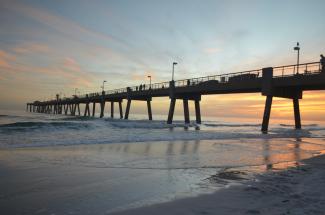The Gulf Coast is no stranger to disaster. Hurricane Katrina in 2005, the BP oil spill in 2010, Hurricane Harvey in 2017 have all left their mark on communities from Florida to Texas. The COVID-19 pandemic adds another layer of complexity to Gulf Coast resiliency.

Economically, COVID-19 and its associated shutdowns have affected the thriving industries of the Gulf. A Brookings study identifying economic vulnerability to pandemic-related shutdowns noted that the five most vulnerable sectors nationwide are oil and gas, transportation, employment services, travel arrangements, and leisure and hospitality. Mapping this vulnerability, metropolitan areas dependent on the energy industry in Texas and hospitality-based economies along the coast of Mississippi and Alabama were likely to suffer due to shutdowns. The pandemic has also halted the Gulf Coast’s fishing industry as restaurant demand has dropped. Florida and Louisiana rank in the top 10 states with the greatest increases in unemployment applications since the beginning of the pandemic. These indicators point to potential long-term effects on the livelihoods of Gulf Coast residents.
Environmentally, the pandemic adds yet another health threat to the existing risks from polluting industries that are scattered across the Gulf Coast. The oil and gas industry provides thousands of jobs in the Gulf, but it also produces fine particulate matter (PM 2.5), a type of air pollution that researchers have linked to aggravated asthma, decreased lung function, and other respiratory symptoms. These same respiratory diseases are classified as pre-existing conditions that can lead to fatal COVID-19 outcomes. A study published by the Harvard T.H. Chan School of Public Health has found that an increase in long-term exposure to PM 2.5 increases COVID-19 mortality. In Louisiana, the Tulane Environmental Law Clinic found that 8 out of the 10 parishes most impacted by COVID-19 lie within areas already exposed to elevated levels of PM 2.5 from the oil and gas industry.
Resiliency also affects Gulf Coast socio-economic groups differently. Across the United States, cities and states such as the District of Columbia, Milwaukee, St. Louis, Michigan, and Illinois have released data demonstrating that African Americans suffer a disproportionate number of COVID-19 related deaths. The story is no different in Mississippi and Louisiana: as of April 10, 2020, African Americans made up 70% of deaths in Louisiana though only 32% of the population. Scholar Robert Bullard identifies past land use decisions and slavery as contributing to the current racial disparity in COVID-19 deaths. Louisiana Governor John Bel Edwards has convened a Health Equity Task Force to investigate.
Finally, Gulf Coast residents are concerned about how COVID-19 will impact responses to the hurricane season. The National Oceanic and Atmospheric Administration is already predicting an “active” hurricane season, with an estimated six to ten hurricanes. Across the country, many are wondering how social distancing protocols will be maintained in evacuation zones. FEMA’s recently published COVID-19 Pandemic Operational Guidance for the 2020 Hurricane Season provides some guidance to state, local, tribal, and territorial governments in this area.
Despite these threats, the resilience of the Gulf perseveres. Local politicians are fighting to ensure their communities receive testing. Environmental advocates continue to fight for the right to clean air and water in their area. And ELI’s Gulf Program remains committed to providing technical support for communities in the Gulf. If there are webinars or other resources that would be helpful to you during this time, please do not hesitate to contact us at gulfofmexico@eli.org.
